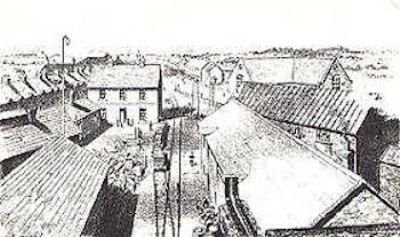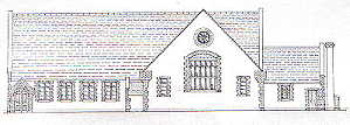
|
|
|
The Severn Railway Tunnel.
Chapter 6 - A Collapse in the Tunnel.
With an increase in the workforce, most of the work now concentrated on opening out the headings into the full-sized tunnel. As mentioned in a previous chapter, the main difficulty in the construction of the Severn Tunnel was in the decision to lower the headings by 15 feet so that the opening out of the headings was at the sides and the top and a semi-circular brick lining was then installed. Finally, the heading was opened out downwards whilst supporting the lining above.
At the end of January 1882, the section about 180 feet east of the New Shaft at Sudbrook had been opened out at the top and sides, and then the roof was supported by a timber in
preparation for the bricklayers to install the semi-circular brick lining. It was noticed that this break-up had removed large amounts of coal shale, but unknown to the men, the coal shale remaining in the roof of the break-up sat below a concealed bed of rock which stood at an angle of 45 degrees. Suddenly and without any warning, this area of remaining coal shale slipped off the rock bed knocking the timber supports away and this section of the tunnel collapsed. Although this occurred under the river, the hard beds of Pennant and conglomerate present in the roof of the break-up prevented the river from entering. Considering that the tunnel was built in 1,500 sections, this was the only section that collapsed along the tunnel's 23,000 feet length; but whereas it took just two weeks to open out this section, it took two months to clear the debris and re-establish the supporting timber.
about 180 feet east of the New Shaft at Sudbrook had been opened out at the top and sides, and then the roof was supported by a timber in
preparation for the bricklayers to install the semi-circular brick lining. It was noticed that this break-up had removed large amounts of coal shale, but unknown to the men, the coal shale remaining in the roof of the break-up sat below a concealed bed of rock which stood at an angle of 45 degrees. Suddenly and without any warning, this area of remaining coal shale slipped off the rock bed knocking the timber supports away and this section of the tunnel collapsed. Although this occurred under the river, the hard beds of Pennant and conglomerate present in the roof of the break-up prevented the river from entering. Considering that the tunnel was built in 1,500 sections, this was the only section that collapsed along the tunnel's 23,000 feet length; but whereas it took just two weeks to open out this section, it took two months to clear the debris and re-establish the supporting timber.
About this time, one of the larger cottages was converted into a hospital with a resident doctor and nurse treating such ailments as congestion of the lungs and pneumonia caused by the hot damp conditions underground. In the early summer of 1882, a purpose-built hospital was commenced incorporating an operating room, an emergency ward and a ward for women and children.
In July 1882, Sir John Hawkshaw was able to report to the directors of the Great Western that 800 yards of tunnel in addition to the top break-up of another 500 yards had been completed and that a start on the massive cutting to the tunnel on the Gloucestershire side of the river had been made in May. Originally, the amount of material excavated from this cutting waste be 366,000 cubic yards but as a consequence of Hawkshaw's decision to lower the tunnel, the amount to be excavated was to be 800,000 cubic yards - in excess of a million tons, however, to build Richardson's sea defences around the top of the cutting would utilise 200,000 cubic yards.
One unusual outcome of the Severn Tunnel works was the draining of several private wells in the area of Portskewett, depriving the inhabitants of their source of fresh water. Realising the effect that this could have, in October 1882 Walker wrote to a local surveyor:
"I think it right to take this opportunity of stating that as an act of grace and favour,
in consideration of the inconvenience caused to the inhabitants of Portskewett
and Caldicot by the drainage of their wells, a water main has been laid to each village
to furnish a supply of fresh water . . . ."
As mentioned in the previous chapter, on the Gloucestershire side of the river, timber houses were built directly over the tunnel due to insufficient room to expand the works in the outlying area. It was thought that the thickness of the red marl over the roof of the heading here was 6 feet, but on the night of the 13th of November the crust of the marl suddenly gave way. Although there was slight damage to the floors of the houses, a brick chimney between two of the cottages shot vertically down into the heading below. On investigation, the layer of marl proved to be just 6 inches thick, and at first, Walker was puzzled by a damage inventory that included the loss of several watches and an amount of money until he realised that these items had been placed in the pockets of trousers and waistcoats hung on nails on the chimney the night before.
The mission room that Walker built was designed to hold 250 people but due to the enlarged workforce at Sudbrook, the partitioning walls of the schoolrooms were removed so that the mission room could now hold 400. By the middle of November 1882 however, the number of people regularly attending the room was often 500 and although Walker had planned to enlarge the mission room, its close proximity to the school made this a difficult. In addition, the day-school was also crowded, but on the night of the 26th of November, a fire totally destroyed the mission room as well as an American organ and several books. The morning after the fire, Walker sketched the plans for a much larger replacement to be  built on part of the three acres of land that he had leased for building houses. Working day and night, often in frosty weather but with benefit of electric lamps, the new mission hall was completed on the 16th of December and the first service in the 1,000 seat mission was held the following day.
built on part of the three acres of land that he had leased for building houses. Working day and night, often in frosty weather but with benefit of electric lamps, the new mission hall was completed on the 16th of December and the first service in the 1,000 seat mission was held the following day.
During the construction of the mission hall, a very frightening experience was felt by all at Sudbrook. Just before 1.00 pm on the 2nd of December, Walker was leaving the hospital after visiting some of the men when he was met by one of his office staff in a state of panic, repeating to him that "The river's in, the tunnel's in". Rushing to the main shaft, he found between 300 to 400 men totally exhausted, while some had lost part of their clothing while others watched the arrival of the large winding cage bringing more men from below. Turning to Tommy Lester, one of the foremen who had just arrived at the surface and who normally worked beyond the Shoots, Walker asked:
'Lester, what did you see?'
'I see nothin', sir.'
'What is it, then?' Walker enquired.
'I don't know, only the river's in', was his reply.
'Where were you working?'
'In number 8 (an area under the English Stones)'.
'And you saw nothing', Walker asked again.
No. It was beyond me'
Turning to another man, Walker repeated his questions:
'Where were you working?'
'In the long heading'
'And what did you see'
'I see nothin', but the river's in', came the reply.
Just then the foreman of the Cornish pumps came to Walker with a puzzled look on his face. 'I cannot understand it', he said, 'there is no increase in the water at the pumps', a fact borne out by Walker and the foreman when they inspected the discharge culvert at the edge of the river. It was also noticed that the water was the same colour as before. Walker decided to go below and together with one of his staff and another foreman jumped into one of the winding cages. After descending the 200 feet to the bottom of the shaft, the three men were witness to an amazing sight: the headings and tunnel were perfectly dry and four or five men were sitting on a piece of timber cleaning their boots. Joseph Talbot, the principal foreman, had got down to the heading by the iron staircase in the pumping shaft and, arriving before Walker and his party, walked up the long heading. He found many items of clothing strewn around the floor with just the ponies by the abandoned skips. But where was the water?
The threat of a river break-in was constantly in the minds of the men, working in a narrow space with water dripping from the rocks overhead and running water at their feet with only the flickering light from a candle to work by, and all the time maintaining a vigil for any unusual sound. However, the normal sounds heard in the headings were totally different from those on the ground due to the blasting of the rock for breaking-up the headings, hammering from the construction of the timber supports in the tunnels and the reassuring thump from the distant pumps.
Suddenly, a warning would ring out and the sounds of a small group of men running through the headings would initiate all the men to rush towards the safety of the shaft which could be over a mile away. The small groups would increase to larger groups as 300 or 400 men ran inside a section of the completed tunnel affording them an easy passage, but where these tunnels connected to the smaller 7 feet headings, it was a case of every man for himself as they trampled over one another in order to escape the impending deluge of water.
Walker was finally able to piece together the events that led up to the men's panic. When Hawkshaw decided to lower the headings, the depths of the shafts were also increased. Between the two Sea Wall shafts, a cross-heading was driven to join the two shafts together. An amount of water was constantly at the bottom of the shafts and when a hole was blasted at the end of one heading, a piece of timber blocked the hole and dammed back the water. A diver was sent down to remove the timber, which then released the water into the long heading under the river. Seeing a large body of fast flowing water coming towards him, just one man was needed to assume that the river had broken in.
Copyright © by John Daniel 2013
